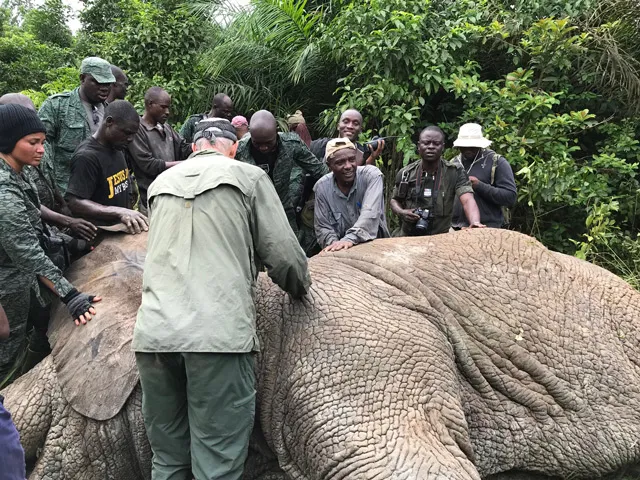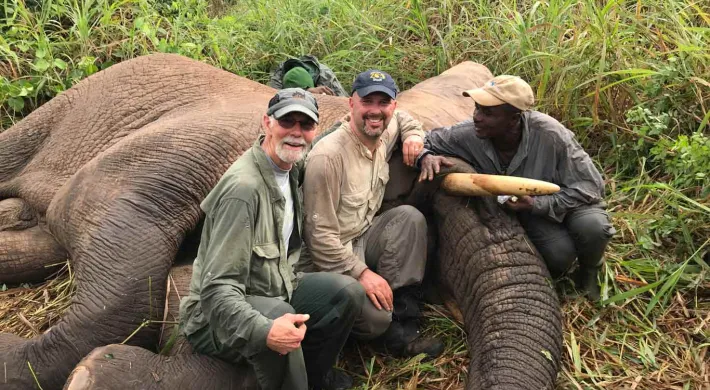Written by Dr. Jb Minter, MS, DVM, DACZM, Director of Animal Health, North Carolina Zoo
We are roughly 8 kilometers, or 5 miles, into our trek for the day and it is just now approaching noon. We were lucky this morning and found fresh tracks only a mile from camp and have been following them ever since. We are hoping to catch up to the elephant herd when they take their afternoon siesta. This is our fourth day in the forest, and we are all feeling really optimistic about this trip because our trackers have located fresh elephant tracks every day we have been in the forest.
Each morning starts the same way with a fresh bowl of rice and beans and a cup of hot tea or instant coffee. The sounds of yellow-billed turacos in the distance are my alarm clock, waking me around 5:30 a.m. It is still dark outside my tent, but I can hear the rustling of others as they go about their business of getting ready for the day. Even this early in the morning, the air is warm and heavy with a sweet, pleasant vegetative smell permeating the camp. Once we all get breakfast and the packs are readied, we head off into the forest looking for fresh signs of elephant activity.
Pictured Above: Elephant dung encountered while tracking group of elephants - a good sign!
The leaves of the understory growth are covered with a thick layer of dew, so within a few minutes you feel as if you just stepped out of a swimming pool wearing all of your clothes. I am wearing longs sleeves and long pants to protect my arms and legs from being thrashed and lacerated from the vines and branches I will have to maneuver through today. To the untrained eye, there is only a towering wall of trees, vines and dense undergrowth. But to a local tracker trained to read the subtle changes in the environment, there is a story to be told. They move ahead of the main group, soft and smooth, making very little noise as they go along their path. Once they pick up fresh signs of the elephant, everyone moves in single file, keeping our voices low. he tracker believes we are a few hours behind the herd, but is hopeful we can catch up to them today. He thinks there are two or three adult animals in this group by the signs he is seeing.
Just after noon, the team stops for a quick break to eat a little lunch in a small clearing. This area of Côte d'Ivoire has tropical forest interspersed with savanna. The team takes a seat on a fallen tree and the excitement of potentially collaring an elephant today is palpable within the group. It is not long before we are back in the bush, following the same set of tracks.
As we move through the forest, conscious of every foot fall, I notice the tracker suddenly throws up his hand, indicating to the team that we need to stop moving. Visually undetectable through the thick forest vegetation, the elephant’s presence is betrayed by the crash of underbrush and the low frequency rumbling sounds. The entire team backtracks the way we came to not spook the elephants while I prepare the anesthetic dart.
Pictured Above: Jb preparing the anesthetic dart
The tracker and I move closer to the elephants. We inch our way along, measuring each step and considering potential escape routes in case they become aware of our presence and charge. The wind is in our favor as we approach the animals, two adult bull elephants. Forty-five yards from the larger of the two bulls, I take aim. I can feel my heart thumping in my chest as I appreciate that this animal has the obvious size advantage and could easily outrun me.
Pictured Above: The collaring team taking a break for lunch while tracking forest elephants
It is clean shot, delivering the drugs into the animal’s hindquarters. The two elephants take off running in the opposite direction. These drugs usually take full effect within 10 minutes, but at least during part of that 10-minute timeframe, the elephant is running full speed away from you and your equipment. I radio to tell the support team that the dart has hit the animal and he is moving quickly in the opposite direction. We give chase for about 15 minutes before we catch up to the bull who is now down in sternal recumbency, or laying on its chest. In this position, the elephant could suffocate under his own weight, so it is pushed into a lateral position, comfortably laying on his side, once he is safe to approach.
Now that the elephant is lying down, everyone knows their roles. Someone is monitoring the animal’s depth of anesthesia so that we do not have an elephant stand up while we are fitting the collar. The 30lb collar is fitted around the elephant’s neck and is bolted into place. Blood is obtained from an ear vein for an overall health assessment of the animal as well as genetic study. Other members of the team stand guard in case the other bull comes back to check on his friend. The whole process takes less than 20 minutes.

Collaring team placing collar on the elephant
The whole team backs away from the bull as I administered drugs to reverse the anesthesia. Within 5 minutes the elephant’s ear starts moving and he is standing within 10 minutes. I observe from a safe distance as the bull recovers. He quickly and quietly disappears into the forest. It is remarkable how such a large animal can appear to just evaporate into the shadows.
Check back next time when I give you an account of surviving an elephant charge.




